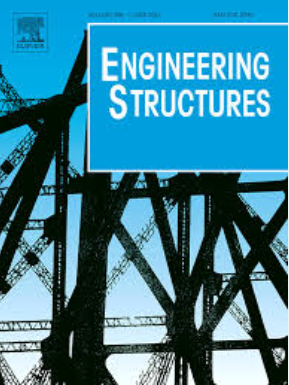一种新的清水碎石砌体抗震重建技术
IF 6.4
1区 工程技术
Q1 ENGINEERING, CIVIL
引用次数: 0
摘要
破坏性地震后,重建有时比修复更可取。在历史中心,这需要在安全和与城市文脉的兼容性之间取得明智的平衡,在这里,保留砖石立面是一项宝贵的建筑资产。本文提出了一种双叶结构的清水面碎石砌体的改造创新技术。内部叶片由增强空心粘土砌体制成,具有抗震性能。外部叶片采用正面的碎石砌体,与原有的立面保持一致,可能使用了从碎片中回收的石头,避免了它们的处理和新材料的供应。在床缝处铺设了玻璃纤维增强聚合物网,连接两个叶片,防止碎石砌体的解体。该技术通过全尺寸原型机在自然地震输入下的面外垂直弯曲振动台试验进行了验证。原型机承受的地震运动强度几乎是2016-2017年意大利中部破坏性地震序列的三倍,最大基底加速度为1.7 g。除了有限的发际裂纹外,未检测到碎石崩解或叶片分离的迹象,测量的相对位移小于1 mm,未检测到残余变形。提供了允许在震后重建中实施所建议技术的设计准则。本文章由计算机程序翻译,如有差异,请以英文原文为准。
A novel seismic-resistant reconstruction technique for fair-face rubblestone masonry
After destructive earthquakes reconstruction is sometimes preferable over repair. In historic centres, this requires a wise balance between safety and compatibility with urban context, where the preservation of the fair face of masonry façades is an invaluable architectural asset. This paper proposes an innovative technology for the reconstruction of fair-face rubblestone masonry, consisting in a two-leaf structure. The internal leaf is made of reinforced hollow-clay masonry, and provides seismic resistance. The external leaf is built in fair-face rubblestone masonry, consistently with the pre-existing façade, possibly using the stones recovered from debris, avoiding their disposal and the supply of new materials. A glass fibre reinforced polymer mesh is laid in the bed joints, connecting the two leaves and preventing the disintegration of rubble masonry. The technique was validated through shake table tests on a full-scale prototype subject to out-of-plane vertical bending under natural seismic inputs. The prototype withstood earthquake motions nearly three times as intense as those recorded during the destructive 2016–2017 Central Italy seismic sequence, the maximum base acceleration being 1.7 g. Apart from limited hairline cracks, no signs of rubblestone disintegration or leaf separation were detected, measured relative displacements were less than 1 mm, and no residual deformations were detected. Design criteria are provided to allow the implementation of the proposed technology in post-earthquake reconstruction.
求助全文
通过发布文献求助,成功后即可免费获取论文全文。
去求助
来源期刊

Engineering Structures
工程技术-工程:土木
CiteScore
10.20
自引率
14.50%
发文量
1385
审稿时长
67 days
期刊介绍:
Engineering Structures provides a forum for a broad blend of scientific and technical papers to reflect the evolving needs of the structural engineering and structural mechanics communities. Particularly welcome are contributions dealing with applications of structural engineering and mechanics principles in all areas of technology. The journal aspires to a broad and integrated coverage of the effects of dynamic loadings and of the modelling techniques whereby the structural response to these loadings may be computed.
The scope of Engineering Structures encompasses, but is not restricted to, the following areas: infrastructure engineering; earthquake engineering; structure-fluid-soil interaction; wind engineering; fire engineering; blast engineering; structural reliability/stability; life assessment/integrity; structural health monitoring; multi-hazard engineering; structural dynamics; optimization; expert systems; experimental modelling; performance-based design; multiscale analysis; value engineering.
Topics of interest include: tall buildings; innovative structures; environmentally responsive structures; bridges; stadiums; commercial and public buildings; transmission towers; television and telecommunication masts; foldable structures; cooling towers; plates and shells; suspension structures; protective structures; smart structures; nuclear reactors; dams; pressure vessels; pipelines; tunnels.
Engineering Structures also publishes review articles, short communications and discussions, book reviews, and a diary on international events related to any aspect of structural engineering.
 求助内容:
求助内容: 应助结果提醒方式:
应助结果提醒方式:


